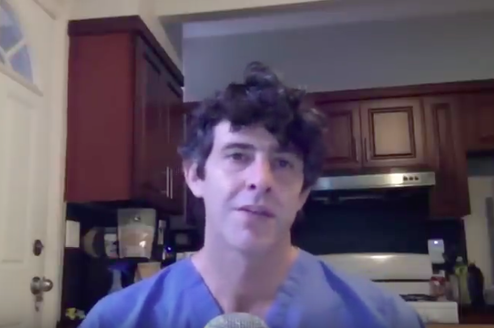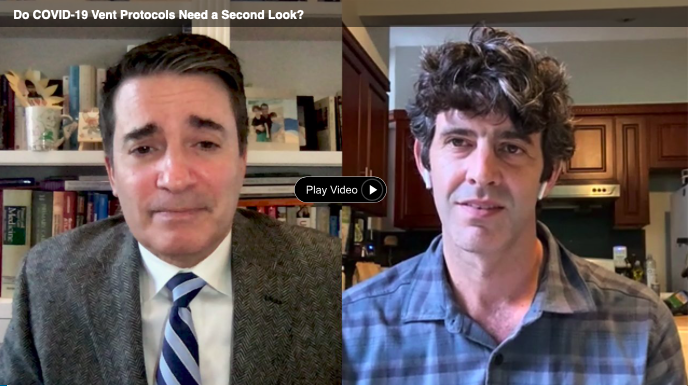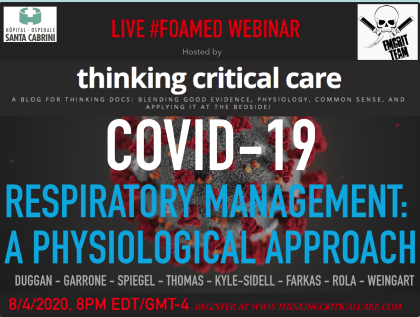|
On March 31, 2020, Cameron Kyle-Sidell, MD a NYC emergency room/critical care physician on the front lines working with COVID-19 patients released a video that has been shared widely on social media; although, to my knowledge, not via mainstream media*. I urge you to listen to what Dr. Kyle-Sidell has to say. Several related resources are listed below including an April 9th webinar from "thinking critical care" entitled COVID-19 Webinar: Respiratory Management, where you will hear Dr. Kyle-Sidell and several physicians from Italy, U.S. and Canada, openly discuss the issues that Dr. Kyle-Sidell has brought to the forefront. Printed excerpts from that webinar are included below. As I was about to publish this post, I discovered a brief update from thinking critical care entitled, "C'EST N' EST PAS ARDS" i.e., "IT'S NOT ARDS." Click here for audio. Cameron Kyle-Sidell, MD Click image for video. I hope this post will not only empower you with knowledge, should you or someone you love require COVID-19 medical treatment; but also encourage you to pray for our physicians who are in uncharted territory with COVID-19 and learning as they go. Especially pray for those who have realized and are honest enough, humble enough, and courageous enough to openly admit that many of the COVID-19 deaths we are seeing are due to well intentioned but iatrogenic medical treatment.
EVMS MEDICAL GROUP EVMS CRITICAL CARE COVID-19 MANAGEMENT PROTOCOL Developed and updated by Paul Marik, MD Chief of Pulmonary and Critical Care Medicine Eastern Virginia Medical School, Norfolk, VA April 6th 2020 “We have zero success for patients who were intubated. Our thinking is changing to postpone intubation to as long as possible, to prevent mechanical injury from the ventilator. These patients tolerate arterial hypoxia surprisingly well. Natural course seems to be the best.” This is not your “typical ARDS”. Mechanical Ventilation may be doing harm. We need to think of alternative treatment strategies. Read more here. This resource includes a "Suggested approach to prophylaxis and treatment of COVID-19." THINKING CRITICAL CARE “A BLOG FOR THINKING DOCS: BLENDING GOOD EVIDENCE, PHYSIOLOGY, COMMON SENSE, AND APPLYING IT AT THE BEDSIDE!” Click here for webinar audio. Click here for brief audio, "C'EST N' EST PAS ARDS" "Bottom line: Stay away from recipe medicine. Assess and re-assess your patient’s physiology." Below are excerpts from the April 9th webinar, "COVID-19 RESPIRATORY MANAGEMENT A PHYSIOLOGICAL APPROACH". “We’re here to share experiences, knowledge, thoughts “all in the hopes of helping to treat our many, many, many critically ill and acutely ill COVID patients.” -Philippe Rola, MD- “…the knowledge we’ve gained with, gained it from a lot of mistakes we’ve made actually because we were hit as the second nation just after China and I guess we were a bit slow in recognizing the key patterns of this disease. We started, actually, with a what was the intubate more or less as fast as you can these patients. Sort of preemptive intubation after a very small CPAP or NIV challenge, and looking back we now recognize that this strategy does not work. It doesn’t work for the single patient because most often these patients don’t fair well once intubated; and frankly intubation does not prevent these people from deteriorating; and secondly, because it wasn’t feasible counting the number of patients we had. So we started off intubating far too many patients and this is the most important lesson we learned and we learned it the hard way obviously…So we gradually shifted from very small CPAP or NIV challenges trials; we shifted off to more pro-longed non invasive strategy and I must say that this has paid off really well. The percentage of patients that have been intubated has been gradually reducing and we have a much better selection now of the patients who really need invasive support..." -Dr. Marco Garrone, MD, ED, Mauriziano Ospedale, Torino, Italy. @drmarcogarrone- “For me, this disease has really changed, forced you to change almost everything you know about medicine and critical care…” -Dr. Rory Spiegel, ED-CC, Washington Hospital Center, Washington, DC. @emnerd- "I realize many questions came from the audience regarding L and H phenotypes, a concept which was rapidly assimilated by those reading and discussing day and night to stay at the cutting edge of the understanding of COVID physiology, so I am including the Gattinoni paper which is the source. For those still thinking of this as ARDS, understand that the single most published author and pre-eminent authority on that disorder states “this is not ARDS,” even if the H type, for those who progress to it – or evolve towards it due to initial management strategies, is fairly similar." -Philippe Rola, MD- Additional Resources...
The Gattinoni paper that is referenced in some of the videos above... COVID-19 pneumonia: different respiratory treatment for different phenotypes?L.Gattinoni1, D.Chiumello2, P.Caironi3, M.Busana1, F.Romitti1, L.Brazzi4, L.Camporota5 COVID-19: Is It Like Mountain Sickness? -- Homeopathy *I'm not sure how mainstream the NY Post is, but kudos to them for carrying this story on April 6, 2020 -- NYC doctor says high ventilator settings damage coronavirus patients’ lungs.
0 Comments
Your comment will be posted after it is approved.
Leave a Reply. |
Author"Why I started researching vaccines." Archives
July 2024
Categories
All
|



 RSS Feed
RSS Feed